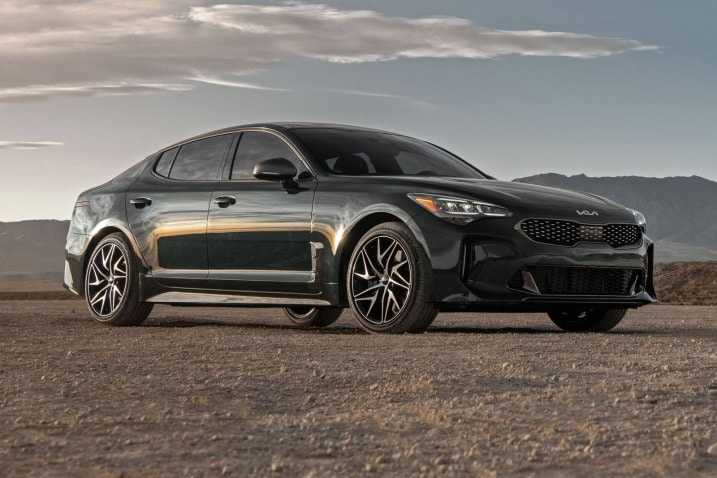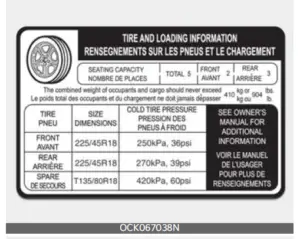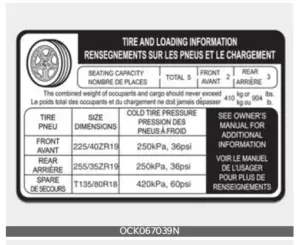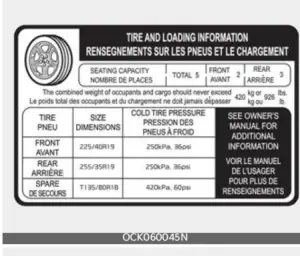Kia Stinger 2023 Economical Operation
The 2023 Kia Stinger is a shining example of automotive innovation. It combines thrilling performance with smart fuel economy in a way that sets a new standard for sports cars. This amazing car, which was made with a keen eye for efficiency, is the perfect combination of speed and economy. Under its sculpted hood is a powerful but fuel-efficient engine that gives the car an exciting start and keeps a close eye on how much gas it uses. The 2023 Kia Stinger has a number of advanced technologies and sleek design features that help it get better gas mileage. This shows that Kia is still committed to green driving without giving up the thrill of the open road. As you travel with the 2023 Kia Stinger, you can expect to find a good balance between speed and fuel economy, with each mile being a testament to the art of efficient operation and the pure joy of driving.
2023 Kia Stinger Specs, Price, Features and Mileage (Brochure)
Economical operation
Your vehicle’s fuel economy depends mainly on your style of driving, where you drive, and when you drive.
Each of these factors affects how many miles (kilometers) you can get from a gallon (liter) of fuel. To operate your vehicle as economically as possible, use the following driving suggestions to help save money on both fuel and repairs:
- Drive smoothly. Accelerate at a moderate rate. Don’t make “jackrabbit” starts or full-throttle shifts and maintain a steady cruising speed. Don’t race between stoplights. Try to adjust your speed to the traffic so you don’t have to change speeds unnecessarily. Avoid heavy traffic whenever possible. Always maintain a safe distance from other vehicles so you can avoid unnecessary braking. This also reduces brake wear.
- Drive at a moderate speed. The faster you drive, the more fuel your vehicle uses. Driving at a moderate speed, especially on the highway, is one of the most effective ways to reduce fuel consumption.
- Don’t “ride” the brake pedal. This can increase fuel consumption and also increase wear on these components. In addition, driving with your foot resting on the brake pedal may cause the brakes to overheat, which reduces their effectiveness and may lead to more serious consequences.
- Take care of your tires. Keep them inflated to the recommended pressure. Incorrect inflation, either too much or too little, results in unnecessary tire wear. Check the tire pressures at least once a month.
- Be sure that the wheels are aligned correctly. Improper alignment can result from hitting curbs or driving too fast over irregular surfaces. Poor alignment causes faster tire wear and may also result in other problems as well as greater fuel consumption.
- Keep your vehicle in good condition. For better fuel economy and reduced maintenance costs, maintain your vehicle in accordance with the maintenance schedule in section 7. If you drive your vehicle in severe conditions, more frequent maintenance is required (see section 7 for details).
- Keep your vehicle clean. For maximum service, your vehicle should be kept clean and free of corrosive materials. It is especially important that mud, dirt, ice, etc. not be allowed to accumulate on the underside of the vehicle. This extra weight can result in increased fuel consumption and also contribute to corrosion.
- Travel lightly. Don’t carry unnecessary weight in your vehicle. Weight reduces fuel economy.
- Don’t let the engine idle longer than necessary. If you are waiting (and not in traffic), turn off your engine and restart only when you’re ready to go.
- Remember, your vehicle does not require extended warm-up. After the engine has started, allow the engine to run for 10 to 20 seconds prior to placing the vehicle in gear. In very cold weather, however, give your engine a slightly longer warmup period.
- Don’t “lug” or “over-rev” the engine. Lugging is driving too slowly in a very high gear resulting in engine bucking. If this happens, shift to a lower gear. Over-revving is racing the engine beyond its safe limit. This can be avoided by shifting at the recommended speed.
- Use your air conditioning sparingly. The air conditioning system is operated by engine power so your fuel economy is reduced when you use it.
- Open windows at high speeds can reduce fuel economy.
- Fuel economy is less in crosswinds and headwinds. To help offset some of this loss, slow down when driving in these conditions.
Keeping a vehicle in good operating condition is important both for economy and safety. Therefore, have an authorized Kia dealer perform scheduled inspections and maintenance.
WARNING
Engine off during motion
Never turn the engine off to coast down hills or anytime the vehicle is in motion. The power steering and power brakes will not function properly without the engine running. In addition, turning off the ignition while driving could lead to working a power-driven steering wheel and hard-to-control steering wheel. Keep the engine on and down-shift to an appropriate gear for an engine braking effect.
2023 Kia Stinger Specs, Price, Features and Mileage (Brochure)
Kia Stinger 2023 Special Driving Conditions User Guide
Special driving conditions
Hazardous driving conditions
When hazardous driving conditions are encountered such as water, snow, ice, mud, sand, or similar hazards, follow these suggestions:
- Drive cautiously and allow extra distance for braking.
- Avoid sudden braking or steering.
- When braking with non-ABS brakes pump the brake pedal with a light up-and-down motion until the vehicle is stopped.
Do not pump the brake pedal on a vehicle equipped with ABS. - If stalled in snow, mud, or sand, use the second gear. Accelerate slowly to avoid spinning the drive wheels.
- Use sand, rock salt, or other nonslip material under the drive wheels to provide traction when stalled in ice, snow, or mud.
WARNING
Downshifting
Do not downshift with an automatic transmission while driving on slippery surfaces. The sudden change in tire speed could cause the tires to skid and result in an accident.
Rocking the vehicle
If it is necessary to rock the vehicle to free it from snow, sand, or mud, first turn the steering wheel right and left to clear the area around your front wheels. Then, shift back and forth between R (Reverse) and any forward gear in vehicles equipped with an Automatic Transmission. Do not race the engine, and spin the wheels as little as possible. If you are still stuck after a few tries, have the vehicle pulled out by a tow vehicle to avoid engine overheating and possible damage to the transmission.
WARNING
Sudden Vehicle Movement
Do not attempt to rock the vehicle if people or objects are nearby. The vehicle may suddenly move forward or backward as it becomes unstuck.
CAUTION
Vehicle rocking
Prolonged rocking may cause engine overheating, transmission damage or failure, and tire damage.
CAUTION
Spinning tires
Do not spin the wheels, especially at speeds more than 35 mph (56 km/h). Spinning the wheels at high speeds when the vehicle is stationary could cause a tire to overheat which could result in tire damage that may injure bystanders.
The ESC system should be turned OFF prior to rocking the vehicle.
Smooth cornering
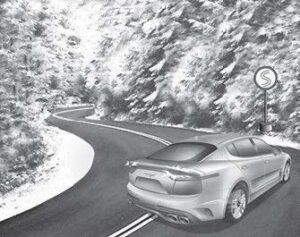
Avoid braking or gear changing in corners, especially when roads are wet. Ideally, corners should always be taken under gentle acceleration. If you follow these suggestions, tire wear will be held to a minimum.
Driving at night
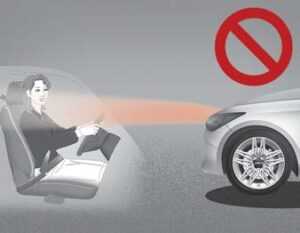
Because night driving presents more hazards than driving in the daylight, here are some important tips to remember:
- Slow down and keep more distance between you and other vehicles, as it may be more difficult to see at night, especially in areas where there may not be any street lights.
- Adjust your mirrors to reduce the glare from other drivers’ headlights.
- Keep your headlights clean and properly aimed. (On vehicles not equipped with the automatic headlight aiming feature.) Dirty or improperly aimed headlights will make it much more difficult to see at night.
- Avoid staring directly at the headlights of oncoming vehicles. You could be temporarily blinded, and it will take several seconds for your eyes to readjust to the darkness.
Driving in the rain
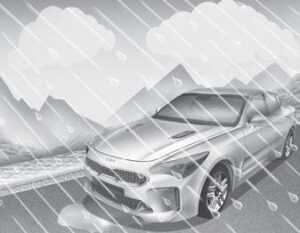
Rain and wet roads can make driving dangerous, especially if you’re not prepared for the slick pavement. Here are a few things to consider when driving in the rain:
- Heavy rainfall will make it harder to see and will increase the distance needed to stop your vehicle, so slow down.
- Keep your windshield wiping equipment in good shape. Replace your windshield wiper blades when they show signs of streaking or missing areas on the windshield.
- If your tires are not in good condition, making a quick stop on wet pavement can cause a skid and possibly lead to an accident. Be sure your tires are in good shape.
- Turn on your headlights to make it easier for others to see you.
- Driving too fast through large puddles can affect your brakes. If you must go through puddles, try to drive through them slowly.
- If you believe you may have gotten your brakes wet, apply them lightly while driving until normal braking operation returns.
Driving in flooded areas
Avoid driving through flooded areas unless you are sure the water is no higher than the bottom of the wheel hub. Drive through any water slowly. Allow adequate stopping distance because brake performance may be affected.
After driving through water, dry the brakes by gently applying them several times while the vehicle is moving slowly.
Driving off-road
Drive carefully off-road because your vehicle may be damaged by rocks or the roots of trees. Become familiar with the off-road conditions where you are going to drive before you begin driving.
Highway driving
Tires

Adjust the tire inflation pressures to specification. Low tire inflation pressures will result in overheating and possible failure of the tires.
Avoid using worn or damaged tires which may result in reduced traction or tire failure.
Never exceed the maximum tire inflation pressure shown on the tires.
WARNING
Under/over inflated tires
Always check the tires for proper inflation before driving. Underinflated or overinflated tires can cause poor handling, loss of vehicle control, and sudden tire failure leading to accidents, injuries, and even death. For proper tire pressures, refer to “Tires and wheels” on pages 8-4.
WARNING
Tire tread
Always check the tire tread before driving your vehicle. Worn-out tires can result in loss of vehicle control. Worn-out tires should be replaced as soon as possible. For further information and tread limits, refer to “Tires and wheels” on pages 7-34.
Fuel, engine coolant, and engine oil
High-speed travel consumes more fuel than urban motoring. Do not forget to check both the engine coolant and engine oil.
Drive belt
A loose or damaged drive belt may result in overheating of the engine.
2023 Kia Stinger Specs, Price, Features and Mileage (Brochure)
Kia Stinger 2023 Winter Driving User Guide
Winter driving
Severe weather conditions in the winter result in greater wear and other problems. To minimize the problems of winter driving, you should follow these suggestions:
WARNING
Driving with summer tires
Summer tires are equipped to provide the best driving performance on dry roads, varying according to specifications.
Do not use summer tires at temperatures below 45°F (7°C) or when driving on snow or ice. At temperatures below 45°F (7°C), summer tires can lose elasticity, and therefore traction and braking power as well. Change the tires on your vehicle to winter or all-weather tires of the same size as the standard tires of the vehicle. Both types of tires are identified by the M+S (Mud and Snow) marking. Using summer tires at very cold temperatures could cause cracks to form, thereby damaging the tires permanently.
Snowy or icy conditions
To drive your vehicle in deep snow, it may be necessary to use snow tires or to install tire chains on your tires. If snow tires are needed, it is necessary to select tires equivalent in size and type of the original equipment tires. Failure to do so may adversely affect the safety and handling of your vehicle. Furthermore, speeding, rapid acceleration, sudden brake applications, and sharp turns are potentially very hazardous practices.
During deceleration, use engine braking to the fullest extent. Sudden brake applications on snowy or icy roads may cause skids to occur. You need to keep sufficient distance between the vehicle in operation in front of your vehicle. Also, apply the brake gently. It should be noted that installing tire chains on the tire will provide a greater driving force, but will not prevent side skids.
Tire chains are not legal in all states. Check state laws before fitting tire chains.
Snow tires
If you mount snow tires on your vehicle, make sure they are radial tires of the same size and load range as the original tires. Mount snow tires on all four wheels to balance your vehicle’s handling in all weather conditions. Keep in mind that the traction provided by snow tires on dry roads may not be as high as your vehicle’s original equipment tires. You should drive cautiously even when the roads are clear. Check with the tire dealer for maximum speed recommendations.
Do not install studded tires without first checking local, state and municipal regulations for possible restrictions against their use.
WARNING
Snow tire size
Snow tires should be equivalent in size and type to the vehicle’s standard tires. Otherwise, the safety and handling of your vehicle may be adversely affected.
Tire chains
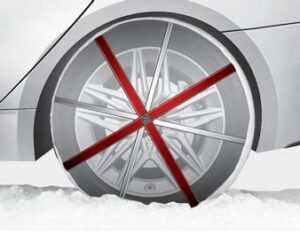
Since the sidewalls on some radial tires are thinner than other types of tires, they may be damaged by mounting certain types of tire chains on them. Therefore, the use of snow tires is recommended instead of tire chains. Do not mount tire chains on vehicles equipped with aluminum wheels; if unavoidable, use Auto-Sock (fabric snow chain). Install the tire chain after reviewing the instructions provided with the tire chains.
Damage to your vehicle caused by improper tire chain use is not covered by your vehicle manufacturer’s warranty.
NOTICE
- Install AutoSock (fabric snow chain) on the rear tires for 2WD vehicles or for AWD vehicles. It should be noted that installing AutoSock (fabric snow chain) on the tires will provide a greater driving force, but will not prevent side skids.
- Do not install studded tires without first checking local and municipal regulations for possible restrictions against their use.
CAUTION
When using AutoSock (fabric snow chain):
- Wrong size chains or improperly installed chains can damage your vehicle’s brake lines, suspension, body and wheels.
- To prevent body damage, retighten the chains after driving 0.3 ~ 0.6 miles (0.5 ~ 1.0 km).
NOTICE
If you hear noise caused by chains contacting the body, retighten the chain to prevent contact with the vehicle body.
Chain installation
When installing AutoSock (fabric snow chain), follow the manufacturer’s instructions and mount them as tightly as possible. Drive slowly (less than 20 mph (30 km/h)) with chains installed. If you hear the chains contacting the body or chassis, stop and tighten them. If they still make contact, slow down until the noise stops.
Remove the AutoSock (fabric snow chain) as soon as you begin driving on cleared roads.
When mounting snow chains, park the vehicle on level ground away from traffic. Turn on the vehicle Hazard Warning flashers and place a triangular emergency warning device behind the vehicle if available. Always place the vehicle in P (Park), apply the parking brake, and turn off the engine before installing snow chains.
- The use of chains may adversely affect vehicle handling.
- Do not exceed 20 mph (30 km/h) or the chain manufacturer’s recommended speed limit, whichever is lower.
- Drive carefully and avoid bumps, holes, sharp turns, and other road hazards, which may cause the vehicle to bounce.
- Avoid sharp turns or locked-wheel braking.
CAUTION
Snow chains
- Chains that are the wrong size or improperly installed can damage your vehicle’s brake lines, suspension, body and wheels.
- Stop driving and retighten the chains any time you hear them hitting the vehicle.
Use high-quality ethylene glycol coolant
Your vehicle is delivered with high-quality ethylene glycol coolant in the cooling system. It is the only type of coolant that should be used because it helps prevent corrosion in the cooling system, lubricates the water pump, and prevents freezing. Be sure to replace or replenish your coolant in accordance with the maintenance schedule in section 7. Before winter, have your coolant tested to assure that its freezing point is sufficient for the temperatures anticipated during the winter.
Check battery and cables
Winter puts additional burdens on the battery system. Visually inspect the battery and cables as described in section 7. The level of charge in your battery can be checked by an authorized Kia dealer or a service station.
Change to “winter weight” oil if necessary
In some climates, it is recommended that a lower viscosity “winter weight” oil be used during cold weather. Refer to “Recommended lubricants and capacities” on pages 8-8. If you aren’t sure what weight oil you should use, consult an authorized Kia dealer.
Check spark plugs and ignition system
Inspect your spark plugs as described in section 7 and replace them if necessary. Also check all ignition wiring and components to be sure they are not cracked, worn or damaged in any way.
To keep locks from freezing
To keep the locks from freezing, squirt an approved deicer fluid or glycerin into the key opening. If a lock is covered with ice, squirt it with an approved de-icing fluid to remove the ice. If the lock is frozen internally, you may be able to thaw it out by using a heated key. Handle the heated key with care to avoid injury.
Use approved window washer anti-freeze in the system
To keep the water in the window washer system from freezing, add an approved window washer anti-freeze solution in accordance with instructions on the container. Window washer anti-freeze is available from an authorized Kia dealer and most auto parts outlets. Do not use engine coolant or other types of anti-freeze as these may damage the paint finish.
Don’t let your parking brake freeze
Under some conditions, your parking brake can freeze in the engaged position. This is most likely to happen when there is an accumulation of snow or ice around or near the rear brakes or if the brakes are wet. If there is a risk the parking brake may freeze, apply it only temporarily while you put the gear shift lever in P (Park, Automatic Transmission) and block the rear wheels so the vehicle cannot roll. Then release the parking brake.
Don’t let ice and snow accumulate underneath
Under some conditions, snow and ice can build up under the fenders and interfere with the steering. When driving in severe winter conditions where this may happen, you should periodically check underneath the vehicle to be sure the movement of the front wheels and the steering components are not obstructed.
Carry emergency equipment
Depending on the severity of the weather, you should carry appropriate emergency equipment. Some of the items you may want to carry include tow straps or chains, flashlights, emergency flares, sand, shovel, jumper cables, window scraper, gloves, ground cloth, coveralls, blankets, etc.
Drive your vehicle when water vapor condenses and accumulates inside the exhaust pipes
When the vehicle is stopped for a long time in winter while the engine is running, water vapor may condense and accumulate inside the exhaust pipes.
Water in the exhaust pipes may cause noise, etc., but it is drained driving at medium to high speed.
Kia Stinger 2023 TRAILER TOWING User Guide
TRAILER TOWING
We do not recommend using this vehicle for trailer towing.
Kia Stinger 2023 Vehicle Load Limit User Guide
Vehicle load limit
Tire and loading information label
The label located on the driver’s door sill gives the original tire size, cold tire pressures recommended for your vehicle, the number of people that can be in your vehicle and vehicle capacity weight.
Vehicle capacity weight:
904 lbs. (410 kg)
Vehicle capacity weight is the maximum combined weight of occupants and cargo. If your vehicle is equipped with a trailer, the combined weight includes the tongue load.
Seating capacity:
Total : 5 persons
(Front seat: 2 persons, Rear seat : 3 persons)Seating capacity is the maximum number of occupants including a driver, your vehicle may carry.
However, the seating capacity may be reduced based upon the weight of all of the occupants, and the weight of the cargo being carried or towed.
Do not overload the vehicle as there is a limit to the total weight, or load limit including occupants and cargo, the vehicle can carry.
Towing capacity:
We do not recommend using this vehicle for trailer towing.
Cargo capacity:
The cargo capacity of your vehicle will increase or decrease depending on the weight and the number of occupants.
Steps for Determining Correct Load Limit
- Locate the statement “The combined weight of occupants and cargo should never exceed XXX kg or XXX lbs.” on your vehicle’s placard.
- Determine the combined weight of the driver and passengers that will be riding in your vehicle.
- Subtract the combined weight of the driver and passengers from XXX kg or XXX lbs.
- The resulting figure equals the available amount of cargo and luggage load capacity. For example, if the “XXX” amount equals 1400 lbs. and there will be five 150 l b passengers in your vehicle, the amount of available cargo and luggage load capacity is 650 lbs. (1400-750 (5 x 150) = 650 lbs.)
- Determine the combined weight of luggage and cargo being loaded on the vehicle. That weight may not safely exceed the available cargo and luggage load capacity calculated in Step 4.
- If your vehicle will be towing a trailer, load from your trailer will be transferred to your vehicle. Consult this manual to determine how this reduces the available cargo and luggage load capacity of your vehicle.
2023 Kia Stinger Specs, Price, Features and Mileage (Brochure)
WARNING
Loose cargo
Do not travel with unsecured blunt objects in the passenger compartment of your vehicle (e.g. suitcases or unsecured child seats). These items may strike occupants during a sudden stop or crash.
Example 1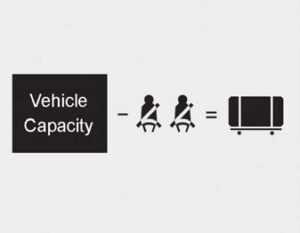
| Item | Description | Total |
| A | Vehicle Capacity
Weight |
849 lbs
(385 kg) |
| B | Subtract Occu- pant Weight 150
lbs (68 kg) × 2 |
300 lbs
(136 kg) |
| Item | Description | Total |
| C | Available Cargo and Luggage
weight |
549 lbs
(249 kg) |
Example 2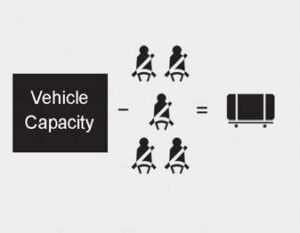
| Item | Description | Total |
| A | Vehicle Capacity
Weight |
849 lbs
(385 kg) |
| B | Subtract Occu- pant Weight 150
lbs (68 kg) × 5 |
750 lbs
(340 kg) |
| C | Available Cargo and Luggage
weight |
99 lbs (45 kg) |
Example 3
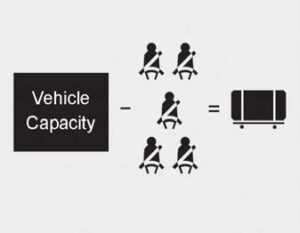
| Item | Description | Total |
| A | Vehicle Capacity
Weight |
849 lbs
(385 kg) |
| B | Subtract Occu- pant Weight 161
lbs (73 kg) × 5 |
805 lbs
(365 kg) |
| C | Available Cargo and Luggage
weight |
44 lbs (20 kg) |
Refer to your vehicle’s tire and loading information label for specific information about your vehicle’s capacity weight and seating positions. The combined weight of the driver, passengers and cargo should never exceed your vehicle’s capacity weight.
Certification label

The certification label is located on the driver’s door sill at the center pillar.
This label shows the maximum allowable weight of the fully loaded vehicle. This is called the GVWR (Gross Vehicle Weight Rating). The GVWR includes the weight of the vehicle, all occupants, fuel and cargo.
This label also tells you the maximum weight that can be supported by the front and rear axles, called Gross Axle Weight Rating (GAWR).x To find out the actual loads on your front and rear axles, you need to go to a weigh station and weigh your vehicle. Your dealer can help you with this. Be sure to spread out your load equally on both sides of the centerline.
WARNING
Over loading
Never exceed the GVWR for your vehicle, the GAWR for either the front or rear axle and vehicle capacity weight. Exceeding these ratings can affect your vehicle’s handling and braking ability.
The label will help you decide how much cargo and installed equipment your vehicle can carry.
If you carry items inside your vehicle – like suitcases, tools, packages, or any-thing else – they are moving as fast as the vehicle. If you have to stop or turn quickly, or if there is a crash, the items will keep going and can cause an injury if they strike the driver or a passenger.
WARNING
Over loading
Do not overload your vehicle. Overloading your vehicle can cause heat buildup in your vehicle’s tires and possible tire failure, increased stopping distances and poor vehicle handling–all of which may result in a crash.
NOTICE
Overloading your vehicle may cause damage. Repairs would not be covered by your warranty. Do not overload your vehicle.
Kia Stinger 2023 Vehicle Weight User Guide
Vehicle weight
This section will guide you in the proper loading of your vehicle and/or trailer, to keep your loaded vehicle weight within its design rating capability, with or with-out a trailer. Properly loading your vehicle will provide maximum return of the vehicle design performance. Before loading your vehicle, familiarize yourself with the following terms for determining your vehicle’s weight ratings, with or without a trailer, from the vehicle’s specifications and the compliance label:
Base curb weight
This is the weight of the vehicle including a full tank of fuel and all standard equipment. It does not include passengers, cargo, or optional equipment.
Vehicle curb weight
This is the weight of your new vehicle when you picked it up from your dealer plus any aftermarket equipment.
Cargo weight
This figure includes all weight added to the Base Curb Weight, including cargo and optional equipment.
GAW (Gross axle weight)
This is the total weight placed on each axle (front and rear) – including vehicle curb weight and all payload.
GAWR (Gross axle weight rating)
This is the maximum allowable weight that can be carried by a single axle (front or rear). These numbers are shown on the compliance label. The total load on each axle must never exceed its GAWR.
GVW (Gross vehicle weight)
This is the Base Curb Weight plus actual Cargo Weight plus passengers.
GVWR (Gross vehicle weight rating)
This is the maximum allowable weight of the fully loaded vehicle (including all options, equipment, passengers, and cargo). The GVWR is shown on the certification label located on the driver’s door sill.
FAQ
Yes, the 2023 Kia Stinger offers an economical turbocharged four-cylinder engine.
The exact fuel efficiency can vary depending on the engine and other factors, but it typically ranges from 22 to 25 miles per gallon in the city and 29 to 32 miles per gallon on the highway.
Some trim levels of the Kia Stinger may come equipped with stop-start technology to improve fuel efficiency.
The 2023 Kia Stinger typically offers various driving modes, such as Eco, Sport, and Comfort, which can impact fuel economy by adjusting throttle response and transmission behavior.
Yes, the Kia Stinger offers all-wheel-drive (AWD) as an option, which may slightly reduce fuel efficiency compared to the rear-wheel-drive (RWD) configuration.
The Kia Stinger is designed with aerodynamic features like its sleek and sporty exterior to help reduce drag and enhance efficiency.
The size of the fuel tank in the 2023 Kia Stinger may vary by trim level, but it’s typically around 15 to 18 gallons.
The Kia Stinger often comes with an eight-speed automatic transmission, which can contribute to improved fuel efficiency.
The 2023 Kia Stinger may offer features like adaptive cruise control and lane-keeping assist, which can help optimize fuel efficiency by maintaining consistent speeds and staying within lanes.
Tire type and size can affect fuel economy. The Stinger typically comes with various wheel and tire options, so it’s essential to consider their impact on efficiency when choosing a trim level.
Regular maintenance, such as oil changes, tire rotations, and air filter replacements, can help maintain the Kia Stinger’s optimal fuel efficiency.
Regenerative braking, common in hybrid and electric vehicles, is not a feature typically found in the Kia Stinger.
To achieve the best fuel economy, it’s recommended to drive conservatively, avoid aggressive acceleration and braking, and make use of the Eco driving mode when available. Additionally, maintaining proper tire pressure and keeping up with routine maintenance can help maximize efficiency.
Useful Link
Kia Stinger 2023 User Guide
Download Manuals: https://owners.kia.com/content/owners/en/manuals.html
2023 Kia Stinger Specs, Price, Features and Mileage (Brochure)

